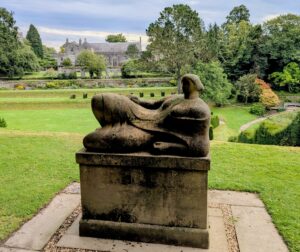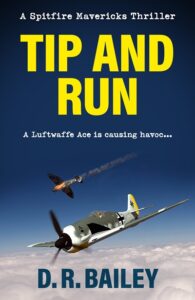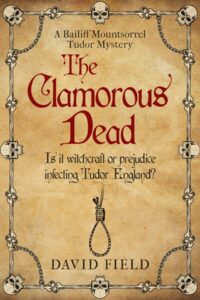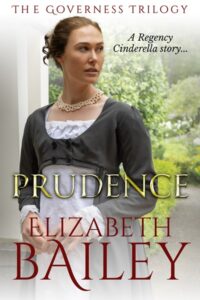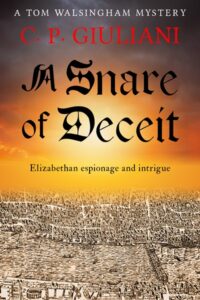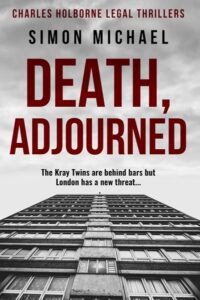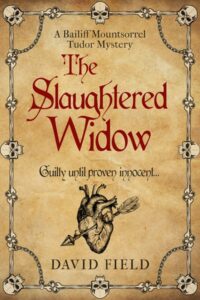Bringing together more than four hundred writers — both onsite and online — the 2024 Historical Novel Society Conference took place at Dartington Hall, a medieval estate in Devon.
This year, the focus was historical fiction on film, TV and stage, but the conference also provided delegates with an excellent opportunity to connect with fellow writers and seek out advice for projects in progress.

Dartington Hall deer park
Among those in attendance were five Sapere Books authors and our Publishing Director, Amy Durant.
Valerie Holmes, author of the Yorkshire Saga Series, reflects on the origins of the society and the conference. “Over two decades ago, I met Richard Lee at a Romantic Novelists’ Association conference. He told me about an idea he had, which led to the forming of a society to champion the historical novel. I happily signed up,” she says. “With dedication and effort, both the Historical Novel Society and the conference have gone on to achieve international success.
“This year, networking and catching up with lovers of historical fiction in the beautiful surroundings of Dartington Hall was truly amazing. I have seen Bernard Cornwell, an early supporter, give entertaining and inspiring talks over the years, and this year was no exception. With an impressive international supporting cast of speakers, attendees and volunteers, the 2024 conference was a triumph.”
C. F. Dunn, who writes medieval and Gothic fiction, enjoyed the accessibility and friendly atmosphere of the event. “The conference provided the perfect opportunity to get to know my editor, Amy, and to meet other Sapere authors in a relaxed and convivial environment,” she says. “It was also wonderful to connect with old friends and make new ones, and to talk with other historical writers from all around the world.”
Kate Robertson, who is working on a Tudor suspense series, valued the opportunity to meet like-minded history enthusiasts. “This was my third Historical Novel Society conference, but my first in the UK,” she says. “One of the things I love about every HNS conference is the time I get to spend with other historical novelists, catching each other up on our progress, roadblocks and research. It’s just such an easy entry — rather than going through the usual layers of questions you get when you’re a writer, I love meeting someone new and just starting with, ‘What time period do you write?’ and the conversation deepens from there. There are very few places where you can guarantee that others will ‘get you’ and understand your nerdiest tendencies!”

Jules Larimore (centre)
Jules Larimore, who is writing a series about the Capetian dynasty, was a panellist for the conference’s session on French historical dramas. “I delivered this session with two colleagues from France’s Splendid Centuries authors’ collaborative,” she says. “We were honoured to be among the presenters at this conference alongside keynote speakers, including Bernard Cornwell, Diana Gabaldon, Kate Quinn, and many others.
“The conference setting was quintessentially English, but our panel focused on stories set in France. While assembling all the aspects of the presentation was time-consuming, my interactions with other authors re-invigorated my enthusiasm for the craft of writing historical fiction.”

Dartington Hall grounds
Amy Durant, Sapere Books’ Publishing Director was invited to attend to lead one-to-one pitch sessions with writers who were attending the conference and she is always impressed with the high calibre of submissions that are presented by members of the HNS. “I always come away from the HNS Conferences excited by the pitches I’ve heard and hopeful that I will be able sign at least one author to Sapere’s list. This time was no exception and hopefully we will have some exciting rights announcements to share soon.”
Christopher M. Cevasco, who is working on a series of Arthurian novels, is the programme chair for next year’s conference in Las Vegas. “I’m very excited about the theme of the 2025 conference, which will celebrate the many subgenres of historical fiction — from historical mysteries and romance to alternate history, military fiction, historical fantasy, and beyond,” he says. “As always, we’re planning a comprehensive, multi-track program with panels, talks, and networking opportunities that should appeal to new and established writers as well as to readers. There will also be a few new surprises in terms of session formats, all designed to explore the ways authors, agents, and editors craft, publish, and market historical fiction in its varied forms.”
All photos by Amy Durant.
We are thrilled to announce that we have signed three new instalments in the Tom Walsingham Mysteries Series by C.P. Giuliani.
The series follows the espionage adventures of Tom Walsingham during the Elizabethan era in Tudor England.
In C.P. Giuliani’s words:
“Tom Walsingham sleuths on! I’m thrilled to have signed up three more adventures featuring my Elizabethan detective and spy with Sapere Books. I have great plans for Tom. He will be tasked with recovering a misplaced foreign ambassador — whose mission could change the course of Anglo-Spanish relations; he’ll become involved in a personal investigation when death strikes at his family home, Scadbury Manor; and poor Tom will find himself in prison when his money troubles and Sir Francis Walsingham’s plans collide. Plenty of mysteries and dangers lie ahead for Tom!
“I’m really happy to be working with Sapere, whose welcoming and stimulating atmosphere and competent, friendly and helpful team have made (and are making) my publishing journey a truly lovely adventure.”
Congratulations to David Field, whose gripping historical mystery, To Kill A King, is out now!
To Kill A King is the fifth novel in the Bailiff Mountsorrel Tudor Mystery Series – private investigation crime novels set during the reign of Elizabeth I and beyond.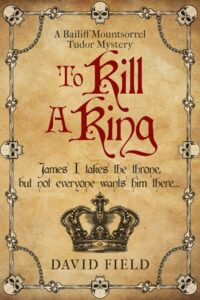
Nottingham, England, 1603
Queen Elizabeth’s long reign has finally come to an end and the Tudor era is over. Scottish King James has been handed the crown of England, but not everyone is happy about that, and there are several plots being hatched to replace him with an alternative.
Bailiff Edward Mountsorrel already has his hands full with an increase in destitute vagrants flooding the county, who seem to be victims of a human trafficker. But before he can find the man responsible, he is tasked by an official with royal authority to infiltrate a local group, who it is rumoured are plotting to assassinate the new king.
Edward enlists the help of fellow bailiff, Francis Barton to find the group, who are hiding out in Sherwood Forest.
But the only way to discover the plot is to place themselves right in the heart of the danger. And there’s a good chance they will be killed before they can save the king…
Who is leading the band of rebels? Can he be stopped?
And is there a connection between the treasonous plot and the desperate vagrants Edward is trying to assist…?
Following the success of his DS Hunter Kerr Investigations and Dr Hamlet Mottrell Investigations, we are delighted to announce that we have signed a new historical police procedural series by Michael Fowler.
In Michael’s words:
“My new series features Detective Winter Cooper of Scotland Yard and is set in the 1950s.
“Detective Cooper’s first case is based upon a real event, the Eastcastle Street robbery — Britain’s biggest cash-in-transit hold-up at the time. In May 1952, robbers used two cars to sandwich a Post Office van in London and escaped with mailbags containing £287,000 (estimated to be worth approximately £8,500,000 today). It was a case that shocked the nation and embarrassed the Government, with Prime Minister Winston Churchill demanding daily updates from the Police Commissioner. Despite the involvement of over a thousand police officers, and the offer of a £25,000 reward, no one was ever caught.
“This is my take on that case, and while it is a deviation from my contemporary novels, I hope readers will embrace Winter Cooper with the same enthusiasm that I have put into creating him and this new series.
“Working with Sapere Books again was an easy decision to make. Over the past five years, they have given me so much support as a writer and I cannot thank them enough. When I ran the idea of this new series past them, their backing was unflinching.”
Congratulations to Neil Denby, whose action-packed Roman adventure, Centurion, is published today!
Centurion is the fourth book in the Quintus Roman Thrillers series.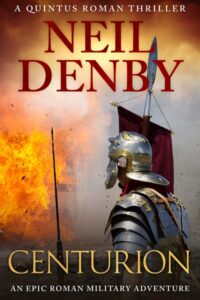
After wintering in Germania, Julius Quintus Quirinius is commanded to gather up the remains of his cohort and meet with General Drusus, who is marching with many legions west down the Rhine from the Alps.
But treacherous enemies and the fickle gods of the weather combine to slow them down. And a new force, led by a mysterious freedom fighter, is organising the local tribes against them.
Desertion plagues them and when the cohort commander is captured, Quintus and the other centurions have decisions to make.
They need to rescue their commander and destroy the fortress where he is being held, but they also need to lead the men to the Alpen passes that point to Rome and home.
Quintus has faith in his companions and knows they respect him in return. But he doesn’t want to test their loyalty by making an unpopular decision.
Can Quintus lead his cohort to victory – and their homeland?
Or will Rome once more remain beyond their reach…?
Congratulations to D. R. Bailey, whose exciting aviation adventure, Tip and Run, is out now!
Tip and Run is the sixth book in the Spitfire Mavericks Thrillers series: action-packed novels set during the second world war and featuring a team of vigilante pilots.
Flight Lieutenant Angus Mackennelly and his team of Mavericks are informed that a new kind of raid is being perpetrated by the Luftwaffe nicknamed a ‘Tip and Run’.
The planes arrive over the Channel, flying extremely low to avoid radar detection, drop bombs and make a quick getaway. These nuisance raids are designed to disrupt the allies and keep their defences on high alert.
Angus takes a trip to the site of the most recent bombing to see if he can discover more about it. And he makes an extraordinary find – a flat piece of stone with an Ace of Spades playing card attached. This was undoubtedly the calling card dropped by the pilot.
Angus is convinced that the same pilot will try again, and he makes it his personal mission to catch the ‘Ace Raider’.
So begins a deadly game of cat and mouse between the Mavericks and the Luftwaffe invaders.
Who will emerge victorious? Can Angus track down and defeat the raider?
Or will the German Ace lure the Mavericks to destruction…?
In this behind-the-scenes blog series, Sapere Books authors offer an intriguing insight into how, where and why they write.
Today, we are delighted to spotlight Valerie Holmes, author of the Yorkshire Saga Series.

Valerie’s study.
Staring out of my study window I see a brick wall. Not a theoretical one that means I have writer’s block, which I do not actually believe in as a professional writer, but a literal brick wall.
This may not appear to be the most inspirational of vistas, but I am fine with it.
Inside my study I am surrounded by my writing workspace; my research books, my trusty printer and personal items that make me smile.
Centre stage is my lovely laptop with its two screens. One is usually displaying research sites and email tabs, the other Word documents — my current WIP.

Castleton Walk, Commondale.
The brick wall rarely gets a glance because, once my laptop is on, I dive into my inner vistas. The beautiful scenery of North Yorkshire’s open moorland and coastline with its sweeping bays and rugged headlands. These are the settings against which my romantic adventures play out. Hence the Yorkshire Saga Series and my many novellas.
It is a world I am familiar with because I grew up in a bay town on the northeast coast and have happy memories of running with my dog along the open expanses of fine sandy beach, climbing the dunes which were covered with needle-sharp marram grass.

Gisborough Priory.
The area is steeped in history, from the old abbeys and market towns to the beautiful city of York. I still return regularly to explore the area: the monk’s trods that cross the moorland, the fishermen’s cottages that line the harbours and the old inns of the bay towns such as Whitby, Staithes and Robin Hood’s Bay. Then there are the manor houses and halls, each with a story to tell — inspiration for my next adventure is found in all. The darker era of smuggling provides further scope to add drama and menace.
 The beauty of having a laptop is that it is mobile. I have written in cafés, on trains, on picnic tables by the sea, and in hotels — but the real work, the editing, polishing and research, happens at my desk, ignoring the blank brick wall.
The beauty of having a laptop is that it is mobile. I have written in cafés, on trains, on picnic tables by the sea, and in hotels — but the real work, the editing, polishing and research, happens at my desk, ignoring the blank brick wall.
I have a flexible routine, writing every day. Life happens, events happen, but the one thing that is constant is the desire to write, which never goes away — or not yet — and I hope never will so long as readers enjoy my adventures.
What better motivation is there for an author to continue to write?
Congratulations to Laura Martin, whose gripping Regency murder mystery, The Dead Curate, is published today!
The Dead Curate is the fifth book in the Jane Austen Investigation series.
Mr Austen’s role as rector of Steventon church has meant that Jane and her sister Cassandra are well connected in the local community.
With Mr Austen indisposed, Jane and Cassandra walk to church to greet the curate, Mr Williamson, who will be leading the sermon in his place.
But when they arrive the church is locked and the parishioners are already milling around outside.
Already fearing something is amiss, Jane rushes home to find her father’s key and when she returns she makes a horrifying discovery.
At first the church appears to be empty, but a series of blood drops lead Jane up into the belfry.
And there she finds Mr Williamson, propped up with iron nails through his hands and feet.
The Austen sisters are used to investigating murders by now, but this one is too close to home…
Who would have a grudge against the unassuming curate? Why his body displayed in such a manner?
And are any other lives at risk in the sleepy village of Steventon?
Congratulations to Graham Brack, whose absorbing historical adventure, The Moers Murders, is out now!
The Moers Murders is the eighth historical murder investigation in the Master Mercurius Mystery series: atmospheric crime thrillers set in seventeenth-century Europe.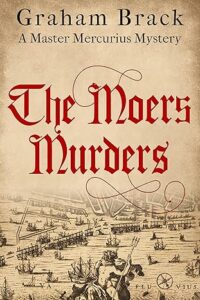
1688, The Netherlands
Master Mercurius has just settled back into his life as a lecturer at the University of Leiden when he is once again summoned by the Stadhouder, William of Orange.
A message from William is never good news, but he is not a man you can say no to.
So Mercurius finds himself once again uprooted and at the centre of dangerous political plot.
William has decided it is time to expand his empire and launch an attack on his nemesis, the French King Louis XIV. And to keep the element of surprise on his side he has decided to march through Germany.
To keep the Germans from blocking him, William has decided to make use of Moers, the German stronghold he inherited which he is allowed to occupy and arm. But he needs someone in control there.
And that is how Mercurius finds himself as the newly appointed Governor of Moers.
William has promised that Mercurius will be executed if the secret plan is discovered, so can the Master keep it under wraps? Or will he be facing the hangman’s noose…?
Linda Stratmann is the author of the Mina Scarletti Mysteries and the Early Casebook of Sherlock Holmes series.
One of the great joys of historical research is discovering untold and fascinating true stories. This is one I found during my reading for Sherlock Holmes and the Cabinet of Wonders, which inspired part of the plot.
On 8 January 1878 an unusual statement was printed on the front page of The Scotsman newspaper. The title was ‘YORICK — WHAT IS IT?’ and the author, announcing ‘challenge accepted’, was one of the most accomplished and famous magicians of his day. John Nevil Maskelyne was a mechanical genius, the constructor of a whist-playing automaton called Psycho. He was the lessee of the Egyptian Hall theatre in Piccadilly, known as ‘England’s Home of Mystery’, where he performed illusions and debunked spirit mediums. He was also, judging by the tone of the piece in The Scotsman, extremely annoyed. His ire was aimed at two men: William Alexander, under whose management a rival of Psycho called Yorick was being exhibited, and the conjuror Boz who took the stage.
After briefly holding the licence of the York Hotel in Weston-super-Mare, Alexander had decided on a new career, promoting conjurors and illusionists. It is not known what previous experience he might have had, but he brought to his profession the ability to manufacture glowing endorsements, shameless theft of other men’s material, and a complete ignorance of the laws of libel.
‘Boz’ was born William Arthur Weston, in Brighton, in 1847. His father was a gunsmith and his mother a dyer. In common with many youthful enthusiasts of the art of conjuring, he had become fascinated with the American Davenport Brothers who toured England in 1864-5, bringing with them a miraculous cabinet. When the brothers were securely tied in the cabinet, all kinds of manifestations were produced, both musical and visual, which many onlookers believed to be the work of spirits. Weston, convinced that their act was trickery, determined to work out how it was done. He chanced to meet George William Buck, a skilled and successful professional conjurer born in 1836, who worked under the name Herr Dobler. The two discovered a mutual interest and pooled their information. After collaborating to perform an exposé of the Davenports’ methods, Dobler hired Weston as his assistant, and they went on tour. In 1866, however, Weston’s father died, and he was obliged to return to Brighton and the trade of dyeing. The flame of ambition still burned, and Weston hoped for an opportunity to take to the stage again.
This eventually came about when he met William Alexander, who by 1875 was managing the career of Herr Dobler. Coincidentally, Alexander had just spotted a new money-spinner, and all he needed was a man with some stage experience who could play a part and was happy to comply with his unusual promotional methods. He terminated his arrangement with Dobler and engaged Weston, who was now advertised as ‘Boz’.
Before long, posters were appearing under the heading ‘Alexander’s Sensations’, advertising Boz and the astonishing Yorick, a whist-playing automaton. The glowing reviews of this extraordinary device were probably written either by Alexander or Weston. Herr Dobler was especially shocked to see that the advertisements were using his playbills and lithographs and were posted in towns where he was appearing. Worse still, Weston was now claiming that he alone had devised the method of exposing the Davenports, and taught it to Dobler, who had been profiting ever since from his work. When Dobler objected, he was accused of being an impostor, taking the name and reputation of another man, a conjuror named Ludwig Dobler who had died in 1864.
Dobler sued both Alexander and Weston for libel and they made a counterclaim against him. The case came before the Bristol assizes in July 1877, where Dobler’s counsel pointed out that English conjurors often performed under foreign names to enhance their attractiveness, ‘for foreigners were supposed to be more clever than English people.’ The case was stopped with the agreement that the imputations would be withdrawn on both sides, and the offensive advertisements not repeated.
Boz and Alexander had suffered little from this spat. They continued their career as before, the advertisements and reviews becoming even more exuberant, the claims more fantastical, and the audiences larger. Their confidence was misplaced, since they had reckoned without John Nevil Maskelyne.
Maskelyne, born in 1839, had been apprenticed to a watchmaker. He became fascinated by stage illusions and seances when he was asked to repair a mysterious mechanical device. The owner was unusually coy about describing its function, and Maskelyne realised that it was used by mediums to fake spirit rapping. After he and his friend George Cooke successfully replicated the Davenport Brothers’ act without the aid of spirits, they commenced a career as conjurers and illusionists and first appeared at the Egyptian Hall in 1873.
Maskelyne had spent more than two years devising and assembling his whist-playing automaton Psycho, the workings of which were a closely guarded secret. He was therefore highly displeased to see Alexander’s advertisements claiming that the young pretender Yorick, which as illustrated on a handbill appeared identical to Psycho, was superior in both construction and operation. However, he had strong suspicions that Yorick, whatever wonders it might perform, was not an automaton.
Yorick and Boz had commenced their glittering career early in 1877 at Weston-super-Mare. Yorick, billed as ‘the most perfect automatic clairvoyant in the world’ was said not only to play whist but also perform mental arithmetic, read, write and spell. It could even, so it was claimed, submit to the test of a naked sword being passed through its body in four distinct places, and being taken to pieces in full view of the audience. There is no evidence that these tests were ever applied.
Yorick moved on to Bristol, the advertisements now boldly claiming that Psycho had been superseded. The tour was in full flow, with bookings pouring in: Liverpool, Manchester and Leicester were to follow.
It was during the Edinburgh appearances in December 1877 that Maskelyne’s patience expired. He and Cooke published newspaper announcements cautioning the public against a ‘gross imposition’ by conjurors exhibiting ‘a trick consisting of a child concealed in an Octagon Box about 24 inches wide and 12 inches deep upon which the bust of a figure is placed’. It was the child, not machinery, that caused the figure to move. Maskelyne did not mind sincere imitations but objected to crude copies said to be superior to Psycho, in an attempt to injure his hard-earned reputation. At the Egyptian Hall, members of the audience were invited to come up onto the stage and examine the interior of Psycho and the box on which it sat, but, he said, the exhibitors of ‘spurious imitations’ could allow no-one to examine theirs.
On 4 January, The Scotsman published Alexander’s response. He claimed that audience members were permitted to examine Yorick, which he insisted was a genuine automaton on the same principle as Psycho. He challenged Maskelyne and Cooke, who he now alleged were simply the exhibitors of a figure made by another man named Clark [sic], to disprove his claims. The wager was worth £100, the loser to hand this sum to the Edinburgh Infirmary.
Maskelyne eagerly accepted the challenge in his statement of 8 January. He had always acknowledged that a friend of his called Clarke had assisted with the theory and early development of Psycho, but he alone had built the mechanism. Crucially, he now revealed the whole of Yorick’s secret. For the last two years, copies of Psycho had been made and sold in London. Although claimed to be genuine automata, they were designed so that their movements could be controlled by a child concealed in the apparatus. Mr Alexander had purchased one and engaged a little boy to work it, and Mr Weston, as Boz, to present it to the public. It was then advertised as the most wonderful automaton in the world, costing £1,000 to construct. During the performance, Boz told his audience that Yorick operated on the same principle as Psycho but was superior. He even claimed that he was the inventor and Mr Maskelyne the imitator.
Maskelyne now issued a devastating counterchallenge. He proposed to send a representative to Edinburgh who would spare no labour or expense to prove that he had just cause for his caution to the public. He offered to place £200 with a committee of Edinburgh gentlemen, to be paid to the infirmary if his statement was shown to be untrue. If it was true, then Mr Alexander was to pay £100 to the infirmary. The loser of the wager was to pay all the expenses of obtaining the evidence and advertising the result in The Scotsman.
William Alexander now knew that the man he had taunted was willing to do everything in his considerable power to defend his reputation. Maskelyne repeated his challenge, which was never accepted.
Alexander continued to expand his operation. He obtained a second figure worked by a child, which he presented as the original Yorick. In February 1878 he had a new sensation to announce. Extraordinarily, he had partnered again with Herr Dobler — the same man who had previously sued him for libel — who would be appearing with a marvellous automaton, similar to Psycho, dressed as a king and called Rex. This association did not last long. Dobler returned to his former act and sued Alexander for unpaid wages.
The performances of Boz and Yorick continued, the advertisements now carefully avoiding libel, but the secret was out, and bookings dried up before the end of 1878.
The magical career of Arthur Weston was in decline. On 1 April 1880, in Dunfermline where he had an engagement as ‘Signor Boz’, he was found dead in his lodgings. He had tied a piece of wetted silk (variously described as a handkerchief or a cravat) about his neck, and twisted it tightly with a poker, thus garrotting himself, a highly unusual form of suicide. He was thirty-three years of age and left a widow and two children.
Herr Dobler continued to perform as a popular and respected conjuror. He died in 1904. William Alexander remains an obscure figure. It is to be hoped that he decided to abandon his dubious career as a promoter of talent.
Sources
Family records on Ancestry.co.uk
White Magic: The Story of Maskelynes by Jasper Maskelyne
Newspaper reports and advertisements, principally The Scotsman and the Era*.
Also the Western Daily Press and Glasgow Evening Citizen.
*Regarding the Era’s report of the libel trial, on Sunday, 5 August 1877 p. 4, titled ‘Rival Conjurers’. Some statements are untrue, when checked against other records. Weston’s father was not a dyer but a journeyman gunsmith and William Alexander was licensee of the York Hotel under that name.
Published thirty years after his death, distinguished Royal Navy escort commander Vice-Admiral Sir Peter Gretton provides an authoritative history of the Battle of the Atlantic. Combining Sir Peter’s expert analysis of the records with his own experience of the war, The Battle of the Atlantic takes the reader to the heart of the action. Subjects range from merchant shipping and the role of Operational Research to the contribution of the Royal Canadian Navy and the strategies employed by the convoys to defeat the ‘wolf pack’ system of attack by the U-boats.
Sir Peter’s son, Vice-Admiral Mike Gretton, explains how the book came to be published:
“My father, the late Vice-Admiral Sir Peter Gretton, drafted a book about the Battle of the Atlantic in the early 1980s, when he was in his seventies and in declining health. The draft book was complete but unedited and with no publisher, and only a few of the planned appendices were completed. In the 1990s — after my father’s death — all his papers were donated to the National Maritime Museum (NMM) for archiving.
“In 2021, I visited the NMM Caird Library and Archive for a separate but related search: my memory — and that of my brother-in-law, General Sir Sam Cowan — is that my father told me of spending some fascinating days at the home of Admiral Karl Dönitz after the latter had been released from prison for war crimes. He had been Head of the German submarine arm, Commander-in-Chief of the Kriegsmarine and — for a short time — Führer after the death of Hitler. Knowing my father’s practices he would surely have kept a note of the visit, and I hoped it might be in the papers. My search of the NMM archives was fruitless, but there was reference to a meeting with Dönitz’s Chief of Staff, Admiral Godt.
“During that visit Librarian Penny Allen pointed out to me that the archives contained the typescript of a draft book by my father about the Battle of the Atlantic, accompanied by a large collection of correspondence and documents relating to the book. A brief skim, and a detailed read of my father’s conclusions, indicated to me that a draft should be available to a wider readership as well as naval history researchers who might visit the NMM archives. This feeling was reinforced strongly by the encouragement of Professor Andrew Lambert, Laughton Professor of Naval History in the Department of War Studies at King’s College. With the NMM, I set about obtaining a version that could be edited, so that it is accessible to a contemporary readership without in any way changing the facts or judgements expressed by my father.
“This version of my father’s draft book is hereby published for everyone to enjoy and learn from. I am indebted to Professor Marc Milner for his advice and comments in his Afterword covering contributions to the history of the war against Allied shipping (1939–45) since the early 1980s when my father wrote his book.”
Also by Sir Peter Gretton:
Alistair Forrest is the author of the action-packed Roman adventures Sea of Flames, Libertas and Vipers of Rome. He is currently working on a new series, The Britannia Conspiracy, set in the period during Caesar’s invasion of Gaul.
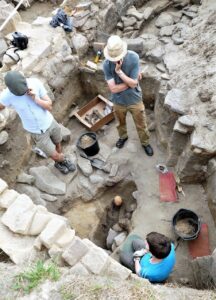
A 3,000-year-old skeleton. Photo: David Nash
Every year I climb into old jeans, don an Indiana Jones-style hat, and dash a hundred yards down the road to assist in an archaeological dig.
I live on the island of Alderney, which just happens to have an ancient Iron Age settlement, on top of which is a Roman village. Next to this is one of Europe’s best-preserved Roman forts, which was built to protect trade routes between Europe and Britain.
I’ve got to know both of the lead archaeologists — Dr Phil de Jersey and Dr Jason Monaghan — and confess that I’d like to know what they know, as long as it fits my ideas for a new historical fiction series.
So far I’ve struck lucky.
We know for sure that Iron Age folk lived and loved on this tiny island a few miles off the Normandy coast. We’ve found the skeletons, complete with bronze torcs and jewellery.
Our team, Dig Alderney, is bent (both literally and figuratively) on scraping away aeons of history to find the story behind these settlements. And at every layer we have been able to confirm that the Romans first came to this Channel Island in around 56 or 55BC when Julius Caesar was conquering Gaul and had set his sights on Britain, just across the English Channel.
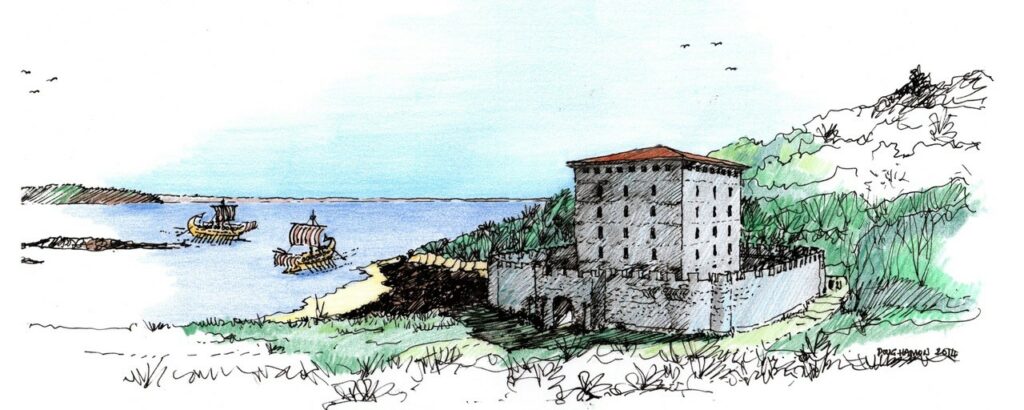
Artist Doug Hamon’s impression of the Roman fort.
Later, the Romans built a fort which has stood intact since the 4th century. Sadly, the huge central tower has long gone, its stonework no doubt used to build medieval houses in the vicinity, and part of the south wall tumbled onto my local beach who knows when, where its parts can still be seen to this day.
The area is crowded with archaeological features. Some relate to German activity (Alderney was occupied during the Second World War) or Victorian fortifications inside and around the fort. Modern roads partly conceal what we know is an Iron Age cemetery discovered in 2019.
Two skeletons were discovered back then. That’s when I got involved after arriving on the island to write, and I was given backroom jobs like pot-washing, shovelling and making sandwiches. Just to be there was a privilege!
This is now a long-term project to learn more about the Roman and Iron Age settlement on Longis Common, a few yards from my home. How extensive is the Iron Age cemetery, and where was the village in which these people lived?
We hope to discover how far the Roman buildings extend, and if this was the site of an earlier Roman fort that predated the 4th century one, or the vicus municipal administration settlement that grew up close to a fort, or a purely civilian village?
Of course, I already know the answers because they’re in my head, as you would expect from an adventurous historical fiction author.

Alderney’s Roman fort today. Photo: Alan Perks
I know I’m on to a winner. Take this exuberant comment by Dr Monaghan: “Finds include pottery, metalwork, glass, building materials, human bones and food remains including animal bones. The finds need to uncover more about the people who lived and were buried there. We want to learn about their lifestyle and how ancient Alderney was connected to the wider world.”
I’d call it making the facts fit a good story, and I’m already well into book two of The Britannia Conspiracy series. This series begins with coded messages from Julius Caesar to attend a secret conference on this island to plan his expeditions to Britain.
Should it be a full-on invasion, or a trade expedition? Either way, he’s in for some surprises, especially as far as the local Celts are concerned!
Congratulations to David Field, whose twisty Elizabethan mystery, The Clamorous Dead, is published today!
The Clamorous Dead is the fourth historical thriller in the Bailiff Mountsorrel Tudor Mystery Series – private investigation crime novels set during the reign of Elizabeth I and beyond.
A routine hanging at Gallows Hill is disrupted when a wild woman begins screaming a curse on the execution site, calling down nightly visitations from the undead to claim the souls of the living.
County Bailiff Edward Mountsorrel attempts to pursue her, but she vanishes into thin air.
Nightly thereafter, Gallows Hill is the scene of ghastly happenings that Edward is ordered to investigate. Rumours of witchcraft infiltrate the county and the bailiff is sent to arrest a local woman, suspected of devilry.
Edward finds her and realises she is merely a wise woman with ancient knowledge of herbs and medicine and with no ill intent. He decides to hide her to keep her safe from those calling for blood.
But his efforts are complicated by the arrival of a professional witch-hunter from Scotland, who is scouring the length and breadth of England in a blood-thirsty mission to destroy any woman, man or child found guilty of sorcery.
As mass hysteria and prejudice threaten to engulf the country, can Edward bring justice to his county, while still keeping his morals intact? Or will innocent women be thrown to the wolves…?
Congratulations to Ava McKevitt, whose absorbing historical adventure, A Goddess Scorned, is out now!
A Goddess Scorned is the second book in the HERA Greek Myths Retold Series.
The Queen is back … and she’s out for revenge…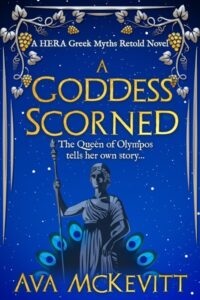
The Goddess Hera, Queen of Olympos, has endured thousands of years of lies being spread about her. And now she is ready to set the record straight.
The Muses were employed by Hera’s brother-husband Zeus to craft a narrative that makes him a hero – and makes Hera a deceiver and a harlot.
But Queen Hera is sick of history favouring controlling men and demeaning the women suffering beside them.
As the patron goddess of women, marriage, and motherhood, it is Hera alone who can set the record straight and redeem her reputation – and the reputation of many women like her – from the slander that has so far been spread.
What really happened under Zeus’s rule? What part did Hera play?
And how did she really feel about the great King of the Gods…?
In this behind-the-scenes blog series, Sapere Books authors offer an intriguing insight into how, where and why they write.
Today, we are delighted to spotlight Patrick Larsimont, author of the Jox McNabb Aviation Thrillers.

Patrick’s winter writing area
My writing has two modes, much like the clock, British Summer Time and Greenwich Mean Time. Living by the sea in Dorset, the weather rather sets the mood and often my productivity.
In the winter, when it’s darker, I get up early and write directly onto my computer. Earlier this year, I acquired two largish monitors, which I have side by side on a stand, below which I have my MacBook Pro. My desk is invariably covered in paper, notebooks and little bibelots that keep me interested, amused and inspired.
When I glance at the nearby window ledge, I see a toy metal Spitfire in desert camo with a spinning propellor, and a pair of painted tin soldiers (not by me), one a bagpiper in full regalia, the other a 1940s RAF pilot, inscribed on the bottom as ‘Hurricane Ace, Battle of Britain.’ Finally, there’s my grandfather’s little silver boar, a memento of his own service during the war. It bears the motto, ‘Résiste et Mords,’ which got him through many battles and the camps. He’s gone now, but just seeing that pig always rids me of any writer’s block, knowing full well that I’ve had it much easier than him.
In winter mode, I stare at a radiator and the world comes to me through my monitors, making me feel like some sort of chaotic air traffic controller. Heaven help the pilots in my care, although old Jox McNabb is holding his own. I generally aim for twelve hundred words a day and have a weekly target of at least five thousand. It’s a cadence I can manage and feeds my nature as an impatient man.
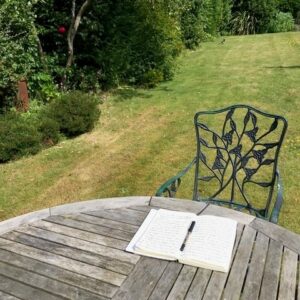
Patrick’s summer writing area
In the summertime, the process becomes two-staged. I write first in my notebook, in terrible doctor-style handwriting, sometimes so awful I can’t even decipher my own hieroglyphics. I can write anywhere — on the beach, at a coffeeshop (rarely) or in our garden (most often), and train journeys are good too. I don’t get too comfortable and like to just write, setting myself the target of twelve notebook pages per session. I then type up, embellish and edit whenever I fancy. Generally, I do about four drafts, plotting out a rough chapter breakdown at first, with two or three sentences for each. Invariably, that synopsis changes, with chapters budding off like yeast.
For inspiration, I depend on the internet and my constantly growing pile of to-be-read books, but often I just make stuff up. A lifetime of blagging it helps. When working on the laptop and monitors, the lure of ‘rabbit holes’ is great, and I can disappear for hours, but when grinding through with the notebook, I try to avoid that, although I do usually have my smartphone in my pocket.
If I did have a writing approach, it would probably be something like Nike’s ‘Just Do It’ (that’s the old adman in me), but ‘Résiste et Mords’ would probably do too.
In this behind-the-scenes blog series, Sapere Books authors offer an intriguing insight into how, where and why they write.
Today, we are delighted to spotlight D. R. Bailey, author of the Spitfire Mavericks Thrillers.
 For my aviation novels, I do a lot of direct and indirect research. I read books, watch documentaries, scour historical websites and more. I’m looking for context rather than necessarily actual events. There is a surprising number of things you would never imagine happened continuing to be revealed about World War Two.
For my aviation novels, I do a lot of direct and indirect research. I read books, watch documentaries, scour historical websites and more. I’m looking for context rather than necessarily actual events. There is a surprising number of things you would never imagine happened continuing to be revealed about World War Two.
I’m interested in the what-ifs and that’s where I take my stories. I grew up just after the war and so some aspects of British culture at the time seem to have imprinted themselves upon me. I’m most interested in characters, developing them and their lives, building the stories around them. I have a keen sense of humour and I can’t help adding that into my plots. I’m not trying to write a history book so much as an adventure book set in the era.
I work full-time as a lecturer in Creative Technology, so my writing time is constrained. However, I’ve developed a disciplined approach to writing based on the Pomodoro method, which has served me well. I write in twenty-five-minute bursts, and I must work uninterrupted for that time. I try to complete a certain number of these bursts a day and I track them very precisely in a spreadsheet, which informs me of my writing speed and how much longer I have to go to finish the book. I also edit as I go, not leaving a scene until I’m happy with it. Then, of course, once finished I read through and edit again, but generally, I find I’ve done all the hard work prior to that point.
During term time I write after work for maybe an hour and then more at the weekends until I’ve got my novel done. I am a pretty fast writer, so I’m lucky that way. I also work through a loose synopsis and plot, but my characters often change the story as I go, and it plays in my head as I write it — just like a movie scene.

D. R. Bailey’s writing space
Fortunately, my wife is hugely supportive in every way and makes me delicious meals when I’m in full flow writing a novel. Unfortunately, my cat has no respect for my writing time, and will come and beg for food or strokes regardless of whether or not I’m busy.
My writing space, as you can see, has a lot of cat ornaments; I’m an avid cat lover and we just keep on collecting more. My space is light and comfortable, and I have a nice big screen for composing my words. I’m also surrounded by books, including my own, my daughter’s and my sister’s, who are both successful novelists too. I also have my doctorate certificate on the wall, one of my proudest achievements. I aim to keep writing for as long as I can, completing as many books as I can. I find it one of the most calming and fulfilling things in life. I’m grateful that Sapere Books has given me the chance to get my stories into the hands of so many more readers.
Congratulations to Elizabeth Bailey, whose captivating Regency adventure, Prudence, is published today!
Prudence is the first book in the Governess Trilogy: heart-warming Regency romance novels with strong female lead characters.
Miss Prudence Hursley, orphaned from a young age, has grown up at the Paddington Charitable Seminary for Indigent Young Ladies. Primed for service, she is now ready to take up a position as a governess.
Full of trepidation as she takes the stagecoach to meet her employer at Rookham Hall, Prudence is sad to be leaving Nell and Kitty – her childhood friends who have replaced the family she lost and become like sisters to her.
Prudence has been given a temporary position by Mr Julius Rookham to teach – or tame – his two young wards, who have so far had an unconventional upbringing.
But when Prudence meets Julius she finds his changeable moods disconcerting. And it will take more than a little patience to turn the two unruly girls into refined young women, ready to enter society.
With her future hanging in the balance, can Prudence make herself invaluable enough to secure a permanent position?
And can Nell and Kitty advise her on how to handle the mysterious Mr Rookham…?
Congratulations to C. V. Chauhan, whose heart-pounding thriller, The Right Time To Die, is out now!
The Right Time To Die is the third book in the Inspector Sharma Thriller series: gritty urban police procedurals set in Leicester.
DI Sharma is caught in a lethal race against time…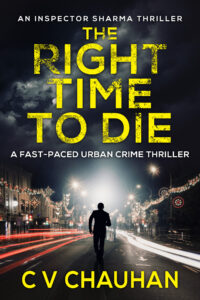
Tensions are running high in the city of Leicester. Recent conflict between groups of Hindu and Muslim youths has led to violence on the streets, which the police are struggling to control.
Despite these events, Sunil Kumar, a Bollywood superstar has been invited to switch on the lights along the Golden Mile for the festival of Diwali.
DI Rohan Sharma is one of the thousands of onlookers that have arrived to enjoy the celebrations.
But Sharma is aware of social media tip-offs that suggest the happy atmosphere could turn deadly…
And his suspicions seem to be confirmed when Sunil Kumar collapses on stage.
With the police chiefs mistakenly believing Sharma could have inside knowledge on the local hostilities, he takes the lead on the investigation.
But when a spate of killings occur, in seemingly unrelated circumstances, Sharma finds himself in over his head.
Sucked into a dark world of race hate and extremism, Sharma uncovers a deadly plot.
Can he stop more murders from occurring? Will he unmask the fanatical killers?
Or will a catastrophe engulf the city of Leicester…?
In this behind-the-scenes blog series, Sapere Books authors offer an intriguing insight into how, where and why they write.
Today, we are delighted to spotlight Alistair Forrest, author of Sea of Flames, Libertas and Vipers of Rome.
For some authors, inspiration is a flash of instant eureka. For me, it’s been more like evolution.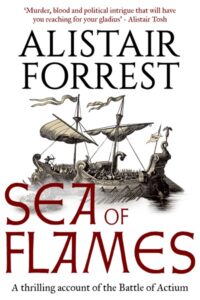
I had never intended to write historical novels centred on the late Roman Republic, but it became inevitable when I moved to Spain with my wife, two-fifths of our children and assorted pets.
Our new home had been built slap bang in the middle of an ancient battlefield. More about that later.
For me, inspiration began in an English lesson at boarding school. One day, evening prep was to write an essay on Macbeth and I hadn’t got a clue how to answer the question. So I flipped to the cover of my textbook, which featured an image of Dunsinane Castle and the encroaching Birnam Wood.
I used my embryonic creative writing skills to describe the scene and thus avoid answering the question, hoping my talent would impress the English teacher, Patrick Cormack.
He wasn’t impressed. He called out my feeble effort in front of Class 4R, announcing that my work was too descriptive, and I wanted the ground to open up and swallow me. But the truth is, I really enjoyed writing that essay.
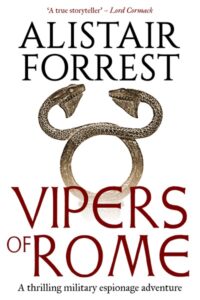 If I had ever summoned the courage to discuss career options with him, he would have said ‘Go and be an accountant’ or something like that. But while he became a politician with a knighthood and later Lord Cormack, I became a humble journalist. Yes, I could write.
If I had ever summoned the courage to discuss career options with him, he would have said ‘Go and be an accountant’ or something like that. But while he became a politician with a knighthood and later Lord Cormack, I became a humble journalist. Yes, I could write.
Years later, on the publication of my first novel, Libertas, Lord Cormack was kind enough to give me an endorsement. “Forrest has the gift of a true storyteller,” he said, with a hint of a chuckle in his email.
My journalism career provided further inspiration. As a pimply cub reporter on the South Wales Echo, the terrifying news editor would peer down the vast newsroom to see who was slacking. The ‘punishment’ was to be handed the latest novel supplied by a hopeful publisher and told to review it by the next day. This happened to me frequently, and I never objected.
Among the many was Gateway to the Gods by Mary Teresa Ronalds, a magical excursion into the ancient world of Babylonia. It clicked for me, because as a child and teenager, I had lived in three Middle Eastern countries. From that moment, I wanted nothing more than to be a writer of ancient stories.
Leap forward decades, and that move to Spain. My wife and I chose a house amid well-tended olive groves in an upland valley opposite Monda (ancient Munda), a charming village in the Sierra de las Nieves Natural Park, not far inland from Marbella.
And it didn’t take long to discover that Julius Caesar had marched his crack legions through our garden.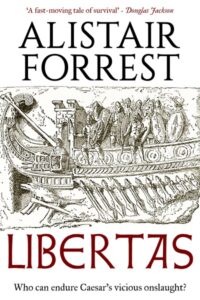
I started writing Libertas, revelling in the scenery and culture, and imagining what the community might have been like when Caesar came.
I developed the theme of an indigenous people who were creative and inventive in their own right. They understood herbcraft and lacked nothing for a full, healthy life.
The hero in Libertas is not a warrior but a thinker. He is appalled at the horror that Rome brings to his hometown.
Living in the same community as my protagonist, separated by centuries in which nothing much happened between Caesar and Franco, enabled me to add colour and feeling to my imagined community of bakers, brewers and cheesemakers.
Happily I can refer to a comment by the Historical Novel Society’s reviewer: “Forrest makes us care about Munda. He captures the tragedy of a people dragged into the horror of a vicious war brought about by circumstances over which they had no control and could hardly understand.”
Such a contrast to my teacher’s comment on my Macbeth essay. But let’s face it, his comment was where inspiration began for me.
In this behind-the-scenes blog series, Sapere Books authors offer an intriguing insight into how, where and why they write.
Today, we are delighted to spotlight Daniel Colter, author of the Knights Templar Thriller Series.
Writers are a strange breed.

The view from Daniel’s window
We invent friends in our heads, decide how they speak, what they wear, where they go, then spend countless hours conversing with them. No two writers share the same head-friends, oddly, despite running in the same social circles. Neither do any two writers develop a story the same way.
Specific routines keep us on track, or don’t (looking at you, internet), and each work proceeds at its own pace. Most writers are one of two species: a plotter or a pantser. A plotter maps out each scene, chapter, and verse before putting fingers to keyboard. Pantsers fly by the seat of their pants, beginning with an idea, then writing towards a vaguely defined ending. I mapped out my first novel, Brotherhood of Wolves, but tossed the map aside by chapter 3. I found pantsing more rewarding, and still do, because much of the fun (and frustration) is writing myself into a corner and finding a path out.
My novels are historical fiction, where history provides setting, culture, and place. History can also frame the plot. Story is given precedent over history, however, because the goal is to entertain, not to educate. One or more characters are historical persons and the fictional protagonist lives within their orbit. Historical fiction should stay true to history and the fiction takes flight where history grows murky — which it usually does, especially the further back in time one travels. The murk is where the fun begins, in my opinion, and its where the what if fleshes out the story, where the pantser finds out what happens to his head-friends.
Writers are also strange creatures.
Some writers have habits, like a dog that circles exactly three and a half times before lying down, and these rituals are intended to fuel creativity. Isabel Allende started her first novel on January 8, 1981, and that day became a ceremonial start date for all her subsequent works. The poet Friedrich Schiller kept rotten apples in his desk and, when his mind needed a jolt, he would give one a sniff.
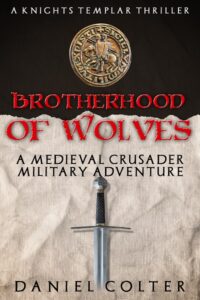 My writing rituals are more mundane and less … smelly. I start with two (not one, not three) cups of coffee. I keep a stuffie of Curious George on my desk, in honour of Curious George Rides a Bike, the first book I read cover-to-cover. I say hello to George each morning.
My writing rituals are more mundane and less … smelly. I start with two (not one, not three) cups of coffee. I keep a stuffie of Curious George on my desk, in honour of Curious George Rides a Bike, the first book I read cover-to-cover. I say hello to George each morning.
Ritual also comes from my father. He was a painter and writer and used a second-hand desk as his art space. I acquired that desk, set to rehabbing it, but foolishly sanded the top to expose wood veneer over composite. I left his dried paint splashes along the edges, though, and I touch them when I write. They make me think of him, and thinking of him puts me in a creative mood. I told him I had begun writing historical fiction, his favourite genre, but he passed away before reading Brotherhood of Wolves. I often wonder what he would think of my series, and suspect he would be pleased (except for the part where I ruined his desk).
In this behind-the-scenes blog series, Sapere Books authors offer an intriguing insight into how, where and why they write.
Today, we are delighted to spotlight contemporary romance author Patricia Caliskan.
I wrote my third novel, When We Were Us, at my bureau, which has become my writing enclave. Something about opening the bureau desktop gives me a sense of immediacy which speeds the writing along. I write upstairs, free from distractions, except for my dogs who stop by to visit, but basically closed off from everything except the world I’m creating.

Patricia’s bureau
I never thought I had any writing rituals until people began asking the question. I realised that I have rituals in general. All three of my novels were largely written at night. Once the demands of the day are over, night-time is not only the perfect fit in a practical sense but allows me the space I need to daydream on behalf of my characters, and fully immerse my thoughts in the world of the book.
I’m a huge advocate of those tiny details which promote wellbeing, even when I’m not writing. So, before I get back to my latest manuscript, I mix essential oils for my diffuser, which works like magic for changing up the mood, and I set a timer to monitor my working hours.
I find having scheduled time slots super helpful. I can show up and do the work and know exactly how much time I’ve spent on the novel, which is reassuring when I’m trying to find enough time to work on a project.
I switch on my moon light, as I call it, a perfect orb of white light, and always freshen up my perfume before I write. I think of perfume as a superpower. A favourite scent signals that we’ve got work to do and someplace else to be.
I usually start by reading over where I left off to reacclimatise. I try not to spend too much time agonising over a word choice or a sentence formation until I’m at the editing stage. I have a natural tendency to edit as I go, wanting the work to be as close to the final manuscript as possible, which can hinder the drafting process.
When it comes to first drafts, I remind myself of my own advice: to just get it all down. I need solitude to do that, and sitting at my bureau, I feel enclosed in the world of the book. When it comes to editing, I usually end up inadvertently making a playlist to score parts of the novel or characters, which I find helpful with tone and pace. Once I have a completed manuscript, I print the work out and read it aloud, because if the writing doesn’t sound right, it isn’t right, and needs reworking.
Writing fiction requires both discipline and detachment, and my little bureau space provides just that!
Congratulations to Eric Helm, whose thrilling Vietnam War adventure, Proxy War, is published today!
Proxy War is the twenty-ninth book in the Vietnam: Ground Zero series: action-packed, authentic historical thrillers set during the Vietnam War.
Republic of Vietnam, 1969
The American government has known for a long time that there were Soviet advisors in North Vietnam, but now it seems they are ready to strike.
Intelligence has been gathered suggesting that Soviet fighter pilots have engaged in aerial combat with American Air Force and Navy pilots.
As of yet the Americans have not retaliated, as the UN is terrified of the Vietnam War escalating into a global nuclear disaster.
But the Soviets have been spotted engaging local Vietnamese troops and it seems they are readying for an attack.
U.S. Army Special Forces Major Mack Gerber and Sergeant Major Anthony Fetterman have been on light duties in Vietnam, during a relatively peaceful period in the war.
But after a visit to a Special Forces Camp, they are told that the enemy have been increasing their assaults on the base.
What are the Soviets planning? How large is their army?
Can the US Special Forces stop their deadly attack…?
Congratulations to Tony Rea, whose thrilling fighter pilot adventure, Bouncer’s Blenheim, is published today!
Bouncer’s Blenheim is the second book in the Gus Beaumont Aviation Thrillers series: action-packed military novels set during the Second World War.
Europe, 1940
After surviving the Battle of Britain, fighter pilot Gus ‘Bouncer’ Beaumont has been promoted to Flying Officer and is posted to a Spitfire reconnaissance squadron.
That is, until Wing Commander Peacock creates another mission for him.
A new top-secret unit called the Special Operations Executive has been formed to gather intelligence on the enemy. And Gus is ordered infiltrate the Greek Resistance and establish their political affiliation.
Mussolini’s army have occupied Greece but the locals have been fighting back. The actions of the civilians seem promising and British Intelligence want to know where the Greeks’ allegiance lies.
To have a chance of success, Gus needs to ditch his plane into the sea and get picked up by the Resistance fighters.
But that is easier said than done … if you want to survive the crash.
Will Gus make it to Corfu in one piece? Can he persuade the Resistance fighters to confide in him?
And can he successfully evade the Italian army…?
In this behind-the-scenes blog series, Sapere Books authors offer an intriguing insight into how, where and why they write.
Today, we are delighted to spotlight Marilyn Todd, author of the Julia McAllister Victorian Mysteries series.

Medieval castle at the bottom of Marilyn’s garden
Living on a French hilltop, with a medieval castle at the bottom of our garden, Roman remains beside a river in the valley, and with the Hennessey Cognac estate on one side, Martell on the other — I couldn’t ask for a lovelier or more tranquil setting.
Okay, there are diggers outside at the moment, replacing water pipes in the very same trenches the electricity people dug (then filled in) exactly one week before. But usually the loudest sound is birdsong, and the mewing of buzzards circling overhead. Just the ticket when you come home bursting with ideas that need to be turned into stories without distractions. From Sicily to Arizona, Sweden to Nova Scotia, I find inspiration everywhere.
Sweden? That was when we were walking a little out-and-back coastal path — worryingly easy to imagine two people going out, but only one of them coming back.
Nova Scotia? Who wouldn’t be inspired by the biggest disaster no one’s ever heard of, when a French ship carrying enough explosives to end the First World War collided with a Norwegian ship coming the wrong way up the channel? The explosion took close to 2,000 lives, injured 9,000 more, destroyed everything in a half-mile radius, spiked a tsunami, and scattered debris several miles inland.
Sicily drew me back to ancient history, inspiring the second book in the Claudia Seferius series, Virgin Territory, as well as Blind Eye — set in Ancient Greece this time, rather than Rome — and debunked the myth of the Cyclops.
As always, Arizona never fails to deliver, especially when my story ‘The Wickedest Town in the West’ scooped an Ellery Queen’s Mystery Magazine award, of which I am ridiculously proud.
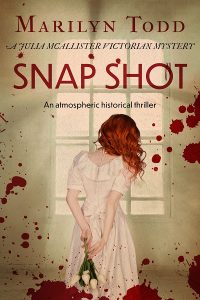 But while we travel a lot, not everything I write is inspired by breathtaking scenery, adventures and legends. My first series with Sapere Books, which kicked off with Snap Shot, was influenced by the emerging science of forensic evidence at the end of the nineteenth century, and the importance of studying crime scenes. Hence Britain’s first crime scene photographer, Julia McAllister.
But while we travel a lot, not everything I write is inspired by breathtaking scenery, adventures and legends. My first series with Sapere Books, which kicked off with Snap Shot, was influenced by the emerging science of forensic evidence at the end of the nineteenth century, and the importance of studying crime scenes. Hence Britain’s first crime scene photographer, Julia McAllister.
My new Firefly series, coming soon with Sapere, tackles the inequalities women faced in Edwardian times, especially domestic violence, which was banned between the hours of 10 p.m. and 7 a.m. because the noise interrupted other people’s sleep. Battling the system is Kitty Sullivan, who runs a gentleman’s club with a fleet of … let’s say exotic dancers, to fund a women’s refuge. Environments that, unsurprisingly, provoke dangerous situations, which Kitty faces down with charm, wit and, of course, a silver Derringer.
After all, there’s no point in having double standards, if you don’t live up to both of them.
In this behind-the-scenes blog series, Sapere Books authors offer an intriguing insight into how, where and why they write.
Today, we are delighted to spotlight Graham Ley, author of the Wentworth Family Regency Saga Series.
 Brittany, really, has been my place for my writing. There lies inspiration and the prompt to be historical, implicit in the ancient stone and timber that surrounds you, and the glimpses from the road of almost hidden farmhouses and squat barns of sturdy beauty — sometimes deserted but strangely still standing. And that region across the Channel has an uncanny relationship with Devon and its history, embedded in its own cob-and-timber beauties, and those oddly contrasting stone manor houses.
Brittany, really, has been my place for my writing. There lies inspiration and the prompt to be historical, implicit in the ancient stone and timber that surrounds you, and the glimpses from the road of almost hidden farmhouses and squat barns of sturdy beauty — sometimes deserted but strangely still standing. And that region across the Channel has an uncanny relationship with Devon and its history, embedded in its own cob-and-timber beauties, and those oddly contrasting stone manor houses.
How better to link the two regions than with the story of a family that was both Devonian and Breton, in the mid-1790s when the buildings were still full of life and yet conflict was raging? It was bound to be the case that at some point I would catch, in passing, the misty outline of the Breton manor that would lie at the heart of the story — a home that had been emptied by the Revolution in France, but which would be gradually restored in quite unpredictable ways. That manor came into being in partnership with another that would be in Devon, both of great antiquity but which had, in different ways, been brought up to date. Two homes that might contain threat as well as comforting familiarity, both put together from what I had seen across the two regions.

Manoir du Val au Houx, Brittany
In the saga, Chittesleigh in Devon and Kergohan in Brittany are manors with orchards and gardens. Both sit in the heart of farmland and woodland, with its capacity to conceal, protect and yet also harbour danger. It was only when I was finishing the fourth and final book of the saga that I stumbled on a truly striking vision of Kergohan, nestling in a valley only a mile or so from where I was staying. Its medieval aspect is pictured here, but it also has a shorter, eighteenth-century façade with a portico. So it seems that you can only sum up when you have finished. In the meantime, a building takes shape from the inspiration and the uncertain lives of its characters: they fill it with aspirations, fears and suspicions, which only their love for each other may come to quieten.
In this behind-the-scenes blog series, Sapere Books authors offer an intriguing insight into how, where and why they write.
Today, we are delighted to spotlight C.P. Giuliani, author of the Tom Walsingham Mysteries Series.

C.P Giuliani’s garden house
Every year, as soon as summer comes, I move my writing to the garden house. It’s not really cooler, as temperature goes, but it feels summery and pleasant. I love the tall ceiling, the terracotta floor, the desk that used to belong to my great-grandfather, and the view onto the garden. There’s a little pond outside the French windows, and the birds bathing or drinking are, I confess, something of a distraction — but they also provide a cheerful break whenever I find myself stuck. A paragraph refusing to take the right shape? A character mutinying? A dull passage? I step away from the desk and watch while the blackbirds play in the water — and, more often than not, a solution will suggest itself.
For all its rustic pleasantness, the garden house has decent Wi-Fi — which is rather essential when my pile of reference books is not enough to confirm some detail — and is equipped with an electric kettle to make cup after cup of tea, which is a fundamental of my writing method.
In truth, beyond the insane amounts of tea, I have little in the way of a writing routine. Working in theatre means that my hours are flexible. Sometimes I write in the morning, sometimes very late at night, sometimes both; sometimes I must snatch the odd hour here and there, between a rehearsal session and a meeting with the techs. One thing I do is to always keep a notebook with me. Through the years, I’ve learnt to keep a dedicated notebook for each project, beside a general one for everything and anything: notes, stray ideas, snatches of dialogue overheard or imagined, lists, questions… It’s the general notebook that I carry around, so I can jot down anything that occurs to me — to be transferred to the relevant one later. This means that I do some of my writing at the theatre, at the vet’s, as I stand in a queue at the Post Office…
My family, friends and colleagues have developed a high degree of amused tolerance for my ‘Notebook Moments’, when I drop whatever I’m doing to take a note; strangers are occasionally a little put out until I explain that, for one thing, I’m prone to forgetting what I don’t write down and, for another, sometimes an idea will present itself in a very iridescent shape, little more than a flicker of colour under the surface of the water — and will need to be recorded quickly and thought through in writing, at least a little, if it’s to be of any use.
So to recap, I’m absent-minded, easily distracted, forgetful, and can’t keep a routine… I suppose it’s no wonder that a quiet, pleasant place like the garden house is important to my writing process.
Congratulations to
Two years on from Julius Caesar’s assassination, his successors still crave vengeance. The massed legions of the new Caesar, Octavian, and Mark Antony face off against Cassius and Brutus at Phillipi.
Leading the charge for New Rome are primus pilus Titus Villius Macer and his optio, Crispus.
Their heroics come to the attention of Octavian’s spymaster, Marcus Vipsanius Agrippa, who recruits them for his Viper network of spies.
Their mission: Return to Titus’s native Sicilia to gather intelligence on its current ruler, Sextus Pompey.
But when Titus and Crispus arrive in Sicilia, they find much has changed while they’ve been fighting with the Fifth Legion.
The woman Titus came home to marry has grown cold and he must face up to domestic troubles while trying to help Agrippa restore Sicilia to Roman rule.
Suspecting a plot to assassinate Rome’s new rulers, Titus will face savage sea warfare against the local pirate fleet.
Can he uncover the deadly plot? Will he save another Caesar from assassination?
And can he save his family from the ravages of war…?
Congratulations to Adele Jordan, whose nail-biting historical thriller, Murder At Greenwich Palace, is published today!
Murder At Greenwich Palace is the first book in the Shadow Cutpurses Tudor Thriller Series. It is an espionage adventure set during King Henry VIII’s reign in England with a feisty female lead.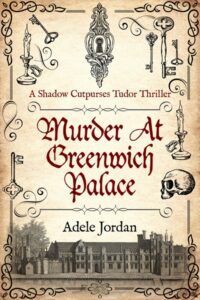
1536, London
Mother and daughter ‘shadow cutpurse’ team, Emlyn and Gwynnie have been stealing to survive for years, but they are ready to make their big break and escape a life of crime forever.
While Emlyn distracts the guards at Greenwich Palace, Gwynnie sneaks inside, searching for the royal jewels that will set them up for life.
But Gwynnie is disturbed in the act and whilst hiding, she sees something she can never unsee.
A man is murdered in front of her.
Gwynnie flees the crime scene but extreme flooding blocks her escape from the palace grounds.
And with the break-in discovered, suspicion for the murder is placed on the thieves.
If Gwynnie admits to what she has seen, she could find herself executed for a crime she didn’t commit.
Can Gwynnie find a way to reveal what she saw? Will she manage to find her way to freedom?
Or will her a career as a cutpurse end in death…?
In this behind-the-scenes blog series, Sapere Books authors offer an intriguing insight into how, where and why they write.
Today, we are delighted to spotlight David Field, author of numerous historical series including the Bailiff Mountsorrel Tudor Mystery Series and the New World Nautical Saga Series.
I’ve always written stories, even as a child, then I progressed from childhood scribbles to more serious attempts at literary glory on an old upright Olivetti typewriter (one of those with a red and black ribbon, if you’re old enough to remember) when my handwriting graduated from ‘untidy’ to ‘execrable’.
Reluctantly I then honoured my mother’s wish, and my father’s insistence, and got a ‘real job’ as a criminal trial lawyer, which was about as relaxing as standing on one leg on the top outer ledge of The Shard in London, without the reassurance of a safety harness. To relieve the stress I decided to start working on a novel — but what should I choose for a genre?
A good friend of mine who already earned a precarious living as a novelist was insistent that one should always write about things that one knows, and by this stage I knew two things outside my professional straightjacket — some history from my schooldays, and the streets of my home town, Nottingham. During the final years of my working life I spent stolen moments imagining the lives of those living in Nottingham during the Luddite Riots, and In Ludd’s Name was eventually published by a boutique publishing house owned by an old school friend.
Bitten by the bug, and buoyed up by having finally been published, I grew ambitious, and searched the history books for possible storylines, most notably from that most colourful of periods of English history, the Tudor era. The literary world seemed to be awash with Henry VIII, Anne Boleyn, Elizabeth I and even ‘Bloody Mary’, but two seminal characters from that era seemed never to have received much attention from novelists.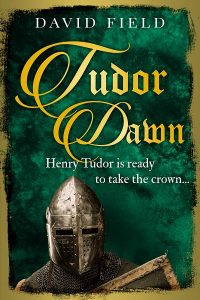
First was the progenitor of the Tudors, the boy from Wales, Henry VII, and I climbed inside his head to bring to the pages that followed his boyhood imprisonment in a bleak castle in South Wales, his youthful exile in Brittany, his triumphant return at the head of a ramshackle army that deposed Richard III at Bosworth, and his love match with Elizabeth of York that brought the Wars of the Roses to an end in the nursery rather than on the battlefield. To my delight, and secret surprise, I found a publisher — Sapere Books — and Tudor Dawn was launched.
Then — unbounded joy and amazement! — Sapere wanted another one, so this time I focused on a butcher’s son from Ipswich who rose from obscurity to become Archbishop of York, Papal Legate for life, Lord Chancellor and the diplomacy coach of choice of Henry VIII. Cardinal Thomas Wolsey’s spectacular downfall was just as dramatic, and The King’s Commoner was published, as testament to the fact that I had a second novel in me.
Dozens of titles have since been published, all by Sapere Books, and all ‘historical’ in genre. As one of the characters in Alan Bennett’s delightful creation, The History Boys, says of history — ‘It’s just one ******* thing after another’, and so it has been for me.
The winners of Sapere Books’ second writing competition have now been announced. Sapere Books pitched six briefs that writers could choose from for their entries, ranging from naval thrillers to Gothic mysteries. The winners have now been chosen – one for each of the six categories – and they have been offered a five-book contract to turn their pitches into a series.

Top row: Jennifer Bruton, David Clensy and Lucy Smith. Bottom row: Jonathan Eyers, Clare Hawkins and Julian Barr.
Amy Durant, editorial director, said: “We had an unbelievable response to this year’s competition with an incredibly high standard of entrants. It was not easy, but we picked our winners due to their clear knowledge of the period they were writing in and brilliant storytelling that left us all wanting to read more. We are very excited to be adding so many talented writers to our Sapere family.”
The Bletchley Park Codebreaker series brief was won by debut author Jennifer Bruton. Jennifer said: “The courageous contributions of the women at Bletchley Park have long held a special place in my heart. To be able to share their story in collaboration with a publisher like Sapere Books is a dream come true.”
Assistant editor Matilda Richards said: “Jen’s brilliantly authentic entry not only provided a detailed description of what Bletchley Park was like for the codebreakers who worked there during the Second World War, but also captures the horrors of war for the soldiers fighting on the front line.”
The World War Two Naval Thriller series brief was won by indie author David Clensy. David said: “I am delighted to be working with Sapere Books on this series, which will allow readers to immerse themselves in the kinds of extraordinary experiences endured by our Royal Navy and Merchant Navy sailors during the Second World War. It is an honour to have this opportunity to commemorate the dedication of a generation who served our nation so valiantly.”
Editorial assistant Claire Smith said: “David’s inspired use of twin main characters joining up to the Royal and Merchant Navies is a fantastic way to explore the thrilling action and perils faced by both services during the war.”
A series chronicling the lives of England’s Medieval Queens has been won by debut author Lucy Smith. Lucy said: “I’m delighted to have been selected by Sapere to write a new series about England’s medieval queens. I can’t wait to immerse readers in the fascinating medieval era and tell the stories of the remarkable Plantagenet women.’
Assistant editor, Natalie Linh Bolderston, said: “Lucy’s submission pulled me straight into the knotty intrigues of medieval Europe. Eleanor of Aquitaine is such a compelling historical figure, and Lucy has done a fantastic job of capturing her cleverness and defiance.”
Non-fiction writer Jonathan Eyers has been chosen to write the fictional Age of Sail naval series. Jonathan said: “I am very pleased my new series will set sail with Sapere Books. I can’t wait for readers to follow Midshipman Newt Beresford across the oceans, into the heart of battle, and up the ranks. I can only hope his adventures are as thrilling and fun to read as they are to write.”
Matilda Richards said: “Jonathan’s well-researched submission showed a passion for the era and a good insight into life aboard ship during the eighteenth century. I’m excited to read more!”
Fantasy author Julian Barr is the winner of the King Arthur Origins brief. Julian said: “Combining historical grit with the otherworldly, the Arthurian Chronicles captures the tragedy and epic scope of this timeless myth. The series situates the legend in sixth-century Britain, following Arthur as he rises from beer-swilling mercenary to true nobility. It’s an honour to work with Sapere Books on bringing the series to life, and I am very grateful that they selected my pitch.’
Editorial assistant Helen Jennings said: “As soon as I started reading Julian’s submission I was immersed in Arthur’s world. His knowledge of Arthurian legend shines through in an exciting series proposal, and his storytelling is vivid and compelling.”
And finally, historical novelist Clare Hawkins is the winner of the Gothic Houses brief. Clare said: “I was delighted to have my entry selected. I love writing to a brief that offers plenty of scope for creating unique plots and characters in engaging historical settings.”
Natalie Linh Bolderston said: “Reading Clare’s submission, I was struck by the strength of her voice and how deftly she planted the seeds of the central mystery. With Clare’s shrewd sense of pacing and her close attention to her story’s setting, it is clear that she has a gift for creating a sinister atmosphere.”
Runner-up spots have also been offered to the following authors, with the prize being three-book contracts to work on a new series: Lynn Bryant, Melanie Golding, Philippa Elliott, Claire Dunn, Christopher Cevasco, Megan Clarke, Samantha Wilcoxson, Jules Larimore, Laura Karim and Carlo Gibbs.
In this behind-the-scenes blog series, Sapere Books authors offer an intriguing insight into how, where and why they write.

Isolde’s writing space
Today, we are delighted to spotlight Isolde Martyn, the author of a number of historical novels including The Lady and the Unicorn and The Knight and the Rose.
Instead of looking out at rose bushes and oak trees or hearing blackbirds, I face an office window that is flanked by palm lilies, and the bird noises come from kookaburras and sulphur-crested cockatoos. None of which is very helpful when I am attempting to describe a scene in fifteenth-century England or thirteenth-century France. Living in Sydney, my research is limited to the occasional overseas trip or the internet. Fortunately, the latter is so fantastic these days and British History Online is now one of my go-to places.
Inspiration? Visiting Carcassonne and Minerve in France and hearing how the Northern French crusaders ransacked the land of the troubadours. Or sometimes it’s someone’s talk quivering my antennae. My second novel, The Knight and the Rose, resulted from hearing a fellow historian cite a rare medieval divorce case that involved a ‘green card’ situation. My third book, The Silver Bride, was hatched from reading of a daughter dressing in armour to fight a duel for her cowardly dad, plus wondering what it would have been like to be a clairvoyant woman back in the 1480s. The Golden Widows arose out of a friend taking me to visit Shute Barton in Devon and hearing about Warwick the Kingmaker’s youngest sister losing seven menfolk in battle. That gave rise to the idea of two young widows on opposite sides in the Wars of the Roses in the early 1460s: Katherine Neville and Elizabeth Woodville.
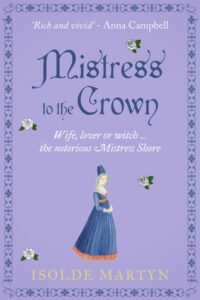 Historical novelists tend to go over the ground with a metal detector trying to find new angles. It becomes a challenge, especially with the Tudors. Fortunately, the character who was trying to get my attention was from the previous century and one of history’s most mysterious wheelers and dealers, the twenty-nine-year-old Duke of Buckingham, Richard III’s cousin, and so the tale of a villain and a loser came to life in The Devil in Ermine.
Historical novelists tend to go over the ground with a metal detector trying to find new angles. It becomes a challenge, especially with the Tudors. Fortunately, the character who was trying to get my attention was from the previous century and one of history’s most mysterious wheelers and dealers, the twenty-nine-year-old Duke of Buckingham, Richard III’s cousin, and so the tale of a villain and a loser came to life in The Devil in Ermine.
‘Write a woman next, a shameless gold-digger,’ suggested my agent. It didn’t work. Instead, on further acquaintance that most appealing of royal mistresses, Elizabeth Lambard — aka ‘Shore’s wife’ — took charge of the writing, and away we went with Mistress to the Crown.
I still envy novelists living in the UK for being able to easily do location research, but living in Australia hasn’t stifled my lifelong interest in… Oh, there goes another kookaburra!
Congratulations to C. P. Giuliani, whose gripping espionage thriller, A Snare of Deceit, is out now!
A Snare of Deceit is a page-turning adventure set during the Elizabethan era in Tudor England. It is the fifth book in The Tom Walsingham Mysteries series.
A new year is being celebrated at Greenwich Palace, but not everyone is in the mood for rejoicing.
Mary Stuart, the imprisoned Queen of Scots has been officially declared a traitor. But Queen Elizabeth is reluctant to sign the death warrant and her mood has been downcast, even in the middle of the festivities.
And the night is soured further when one of the performers is found dead in the tiltyard.
The show must go on, but Tom Walsingham, spying for his cousin Sir Francis, stays behind to investigate. The dead man was no ordinary player, but a man called Jack Perkin, who Tom knew was meant to be passing information to the queen’s confidants about a plot against her life.
With Perkin’s death unlikely to be an accident, Tom feels the danger of the murderous plot escalating out of control. And the player was killed before he could pass on his warning.
But that would place the murderer at court. And dangerously close to the queen…
Can Tom find the killer? Will he uncover the deadly plot?
Or will the web of deceit close in on him…?
In this behind-the-scenes blog series, Sapere Books authors offer an intriguing insight into how, where and why they write.
Today, we are delighted to spotlight Neil Denby, author of the Quintus Roman Thriller series.
Inspiration can come at any time of the day or night, but I find that the small hours are awash with ideas — plot lines, character development, a resolution to a particularly tricky scenario — so it is important that I keep a notepad and pencil by the bed. It may be old-fashioned but it is also reliable and has the advantage of not involving bright screens.
Frustratingly, come morning, I cannot always decipher what I have written down, but sometimes there are gems. These may be character or plot evolution, or perhaps just phrases, but I know I would have forgotten them completely if I had not made a note.
While out walking — an excellent way to clear the brain of fog — I defer to modern technology and record voice notes on my mobile phone. The same principle applies — if there is no immediate record, the thoughts can be lost.
These brief lines are later transferred to a laptop. This is strategically placed in a corner of my study so that I am not distracted by the view outside the window. A row of reference books and one of my favourite possessions, an original Steve Bell cartoon, are all that I have for company. It also helps if I can visualise a character or a place, so I keep a sketchpad on my desk where I can create basic images — maps, plans, sometimes the progress of marches or battles. These drawings help to maintain consistency and authenticity.
This is my primary space, where the words are typed up. I add to them, enhance them, contextualise them, read them back. I often discover that I have used a particular word or phrase twice or more. Or if there is something I’m not sure about, I look it up. The reference books help to straighten out facts and also to find alternative words. Roget’s and Brewer’s and Fowler’s and Chambers provide a wealth of information unmatched by an American-leaning internet. I admit to slipping down rabbit holes of etymology and semantics, but find it strangely satisfying.
I always have to read what has been written, in context with the book so far. Traditionally that would have meant printing the manuscript out and sitting down with a pencil. Happily, that is no longer the case. Instead (thanks to everything going up into the Cloud) I can now read and review on my iPad. This means I can lounge in a chair, or sit outside, or read whilst travelling. So it is more a case of recreating the experience of the reader to see how and if things work.
Of course, there are edits, and actual printouts sometimes, but that is basically it: pencils and pads and technology.
Oh technology, where were you when I had all those essays to write at school?
Congratulations to Alistair Forrest, whose action-packed Roman adventure, Libertas, is out now!
The son of a baker, young Melqart has lived all his life in Munda — an idyllic mountain town untouched by the troubles of Rome.
But when General Pompey sends his sons, Gnaeus and Sextus, to create strongholds and raise new legions, the citizens of Munda find themselves pulled into Rome’s conflicts. Recognising Melqart’s talents as an engineer and strategist, Sextus soon recruits him to his cause.
As tensions between Pompey and his political rival, Julius Caesar, reach breaking point, it seems that Munda is set to become a battleground.
And as darkness begins to fall over his beloved homeland, Melqart must summon all of his courage and ingenuity to save his community from destruction…
Congratulations to Suzanne Parsons, whose thrilling aviation adventure, Secrets in the Sky, is published today!
After a childhood spent carted around the country by her restless mother, Ayda de Corsi finds stability when they settle at the Bound estate in Hertfordshire. And she finds a friend in Lord Bound’s son, Adam.
When a collection of flying machines owned by aviator Thomas Shuttleby is secretly stored at the Estate, Adam hopes flying may gain him notice from his parents and he trains to become a pilot.
Initially, Ayda’s life moves in a different direction, but eventually Adam secretly teaches Ayda to fly and she realises she has found her passion.
When war breaks out in 1914, Adam joins the Royal Flying Corps, while Ayda heads to London as a typist on the promise of a secret, civilian role as Britain’s only female dispatch pilot.
But as a woman, she is not taken seriously, and she finds her flying craft are sabotaged and someone is going to great lengths to stop her from succeeding.
A gifted aviatrix, Ayda must battle to overcome prejudice to fight for her place in a man’s world.
Can Ayda and Adam survive the war? Will Ayda manage to make her mark?
Or are the odds stacked against this daring aviatrix…?
Congratulations to Simon Michael, whose exciting legal thriller, Death, Adjourned, is published today!
Death, Adjourned is the ninth crime novel in the Charles Holborne Legal Thrillers series — gritty, hard-boiled mysteries set in 1960s London.
The Kray twins, the nemeses of Charles Holborne, barrister, are finally convicted of multiple murders and sent away for the longest prison terms ever imposed by a British court.
But with London in the grip of a housing crisis and unscrupulous landlords hiking rents, there are new ruthless enforcers terrorising destitute East Enders.
When a tenant dies during a violent altercation with bailiffs, Charles is instructed to represent the businessmen charged with conspiracy to murder. There is motive, an eyewitness and a confession – seemingly an open and shut case.
But Charles suspects his clients are pawns in a much more dangerous game being played by shadowy Establishment figures.
But are his instincts wrong this time? Is he being manipulated into defending a guilty man?
And as dark secrets are revealed, will he have to choose between moral integrity and professional success?
We are delighted to announce that we have signed a new series of historical naval adventures by Daniel Donato.
In Daniel’s words:
“The series follows English privateer Gideon Locke during Queen Anne’s War, which engulfed the colonies from Newfoundland all the way down to the Caribbean. With the Royal Navy tied up back home, it largely fell to privateers to protect the colonies.
“The story begins in 1707 with Gideon newly returned from a disastrous privateering venture, leaving him destitute and shunned by his fellow privateers. His fortunes change, however, when a charismatic captain recruits Gideon on his next venture. But by the time Gideon realizes that change in fortune was for the worse, it’s too late, and he finds himself caught up in a plot to kidnap the son of a prominent English Governor and deliver him to the French.
“As the series progresses, we’ll see Gideon fight to redeem himself, earn a reputation and climb in rank until he’s ultimately in command of his own vessel.
“I was very fortunate to meet Amy Durant at the Historical Novel Society Conference in Texas last year, and even more fortunate that she was interested in this series. It’s a dream come true to be working with a publisher like Sapere Books who understand that there’s quite a hunger out there for historical action and adventure.”
Following the success of her Jane Austen Investigations series, we are thrilled to announce that we have signed a new dual timeline series set in the modern day and Tudor times by Laura Martin.
In Laura’s words:
“I am absolutely delighted to be writing a new dual timeline series for Sapere. With threads of the present day and Tudor times, as well as hints of the occult, the books are fantastically interesting to research and write. In the present day the series follows two friends — Alice and Lydia — whose lives are ripped apart when Lydia suffers a catastrophic accident whilst they are playing with a Ouija board. Alice tries to move on with her life until it becomes apparent Lydia’s condition is linked to an unsolved mystery in the past.
“Vivacious and charming, Bessie Blount is an immediate favourite at court when she joins the household of Queen Katherine of Aragon. With her skill at singing and dancing she soon catches King Henry VIII’s eye and quickly has to learn how to navigate the intrigue and politics at court. When she falls pregnant with the King’s son she begins to wish for a normal life, but the price she has to pay is watching her firstborn son grow up from afar. She cannot guide Henry Fitzroy through the dangerous world of the Tudor court, and cannot stop worrying about her eldest son’s safety.
“The happenings of the present day and the Tudor times are inextricably linked and only by unravelling the mysteries of the past can Alice have any chance of saving her friend.
“I am thrilled to be working with Sapere again on this new series. The whole team are wonderful to work with and have a way of making the complicated process of producing a book appear seamless.”
In the Jane Austen Investigations series:
We are thrilled to announce that we have signed a new series of Ancient Rome novels by Alistair Tosh.
Alistair is the author of the Edge of Empire series — gripping adventures set in the tumultuous Roman Britain of the second century AD.
In Alistair’s words:
“My new series takes place during the Second Punic War (218–201 BC) between Carthage and the Roman republic in the important theatre of Iberia (Spain/Portugal). It focuses on the lives of two historic figures: Hasdrubal Barca (Carthage) the younger brother of the legendary Hannibal and Gnaeus Cornelius Scipio (Rome), uncle of the famous Scipio Africanus. The novels will follow the ebb and flow of their lives and fortunes as their armies struggle for dominance of the land and its warring tribes.
“I discovered the stories of Hasdrubal and Gnaeus quite by accident. Last year I spent several months in Andalusia, Spain and was seeking a subject for a magazine article to aid with the marketing of my most recent trilogy. I thought of writing something about Rome’s impact on the province and during my research stumbled across their story. There’s a lot to tell.
“I am delighted to be working with Sapere Books. It was clear from the start that Sapere not only treat their authors fairly but understand the commercial fiction market, has scale, industry expertise and a strong focus on digital marketing.”
Congratulations to Patrick Larsimont, whose thrilling wartime adventure, The Vulcan and the Straits, is out now!
The Vulcan and the Straits is the fourth book in the Jox McNabb Aviation Thrillers series: action-packed, authentic historical adventures following a young RAF pilot during the Second World War.
Autumn, 1942
Fighter pilot, Jox McNabb has survived the desert and the second battle of El Alamein, but now No. 111 Squadron is heading into a fresh new storm.
They embark on Operation Torch, the invasion of Vichy North Africa, but adverse weather conditions make flying almost impossible.
And their Commanding Officer, Tony Bartley is losing control as he becomes more and more dependent on alcohol.
After a rocky few months, and a final disastrous mission, it is decided that Jox should step up to Squadron Leader.
But as the North African campaign worsens and Bartley becomes increasingly erratic, Jox finds himself fighting an uphill battle.
Is Jox up for the challenge of command? Can he lead his men to victory?
Or are circumstances too stacked against him…?
Congratulations to D. R. Bailey, whose exciting wartime thriller, Tides of Change, is out now!
Tides of Change is the fifth book in the Spitfire Mavericks Thrillers series: action-packed aviation adventures set during the second world war and featuring a team of vigilante pilots.
After a tense encounter with attacking Focke-Wulfs, Flying Officer Angus Mackennelly returns to base to find Squadron Leader Bentley announcing the bombing of Pearl Harbor.
US forces are being drafted in as war is declared on Japan and an American airbase is to be established next to the RAF Banley base used by the Maverick Squadron.
Angus is promoted to Flight Lieutenant and is given orders to lead a squadron escorting the American bombers on short-range missions until they have their own escort fighters.
But after the US bombers have landed, the Germans stage an attack on the airbase and rumours start to circulate that there may be an enemy spy on base.
As Angus and the Mavericks prepare for more intense air battles over Europe, suspicion between the team grows.
Is there a spy? Are they only targeting the Americans?
And can Maverick Squadron prepare their new allies for the realities of war…?
We are delighted to announce that we have signed a new series of Tudor mysteries by Kate Robertson.
In Kate’s words:
“The series follows Anne Winston, a lady at the court of Queen Elizabeth I. Quiet and unassuming, she is a keen observer and has a skill for puzzling out problems.
“When we first meet Anne, she has just returned to court from burying her husband. She soon learns that her nephew has been arrested for sedition and must race against the clock to prove his innocence while also being drawn into the emerging spy network under Sir William Cecil, the Secretary of State.
“As the series progresses, we will see Anne uncover intrigues and conspiracies, using her powers of observation and ability to go unnoticed in most situations. I wanted to write a story about an older female protagonist who discovers the power of her voice and finds her agency in a complicated world, all while trying to right wrongs and find justice for the forgotten.
“I met Amy Durant at the Historical Novel Society Conference in San Antonio in 2023. I initially pitched her a different story but when she asked what else I had, I knew I needed to share Anne, my most personal protagonist, entrenched in the Tudor era, which is my first historical period love.
“I’m excited to work with Sapere — it’s inspiring to work with a publisher that knows and loves historical fiction so well.”
Congratulations to Ava McKevitt, whose exciting historical adventure, Queen of Heaven, is out now!
Queen of Heaven is the first book in the HERA Greek Myths Retold Series.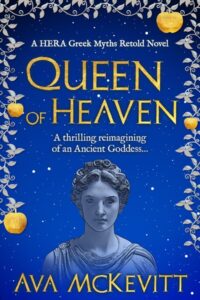
Divine daughter. Jealous lover. Goddess of motherhood. Vengeful wife. Queen of Olympus.
Hera is woman incarnate. And woman scorned.
The powerful goddess has never agreed with the way her story has been told and now the time has come for Hera to set the record straight.
Ripped from the stomach of her father by her brother Zeus, Hera’s beginning was violent and unnatural.
And her life on Olympus was overshadowed by that of her brother-husband Zeus.
But who was the real Hera? What made the revered goddess of matrimony and motherhood?
And how did the daughter of Time become the queen of Heaven…?
We are delighted to announce that we have signed a series of Roman military adventures by Jeff Jones.
In Jeff’s words:
“Legion of the Damned is set in the middle of the first century when Rome was arguably at the pinnacle of its power and follows the career of Marcus Corvo, a man seemingly destined to forever live in his ancestors’ shadows. After a reckless act of bravery turns the tide of a battle, Corvo expects to be severely punished but is instead promoted and recruited for a clandestine rescue mission deep in enemy territory. But this is no ordinary mission and Corvo is obliged to recruit men from the gladiatorial arenas, prisons and mines. His small force is to comprise of expendables — a legion of the damned.
“In the coming series, Corvo’s adventures will take him and his men from the desert sands of Parthia, to the forests of Germania and then to Britannia where he will arrive in time to be caught up in Boudicca’s rebellion.
“The idea for Legion of the Damned has been bouncing around in my head for some time now and my original intention was for it to be made into an historical fantasy novel. When Sapere Books asked whether I’d be interested in writing Roman historical fiction I jumped at the chance. I knew that I could make the idea work.”
Congratulations to David Field, whose gripping historical mystery, The Slaughtered Widow, is published today!
The Slaughtered Widow is the third instalment of the Bailiff Mountsorrel Tudor Mystery Series – private investigation crime novels set during the reign of Elizabeth I and beyond.
Town Bailiff Francis Barton has been arrested for the murder of his former lover, the widow Agnes Timberlake, and the case against him is a strong one.
Agnes was hacked to death where she lay in her bed and Francis was found standing next to her body, with both his clothing and his sword covered in her blood.
And there is a motive. Agnes had recently loaned Francis her entire life savings and was believed to be demanding an accounting for them.
Despite the overwhelming evidence against him, Francis’s friend, County Bailiff Edward Mountsorrel, refuses to believe that Francis is guilty and sets out to investigate for himself.
Edward wants to speak to the serving girl from the widow’s house who may have been the last to see her mistress alive, but she has vanished.
Is the girl running from a guilty conscience? Or has she also fallen victim to the killer?
Time is running out for Francis. Can Edward clear his friend’s name … or is it time to accept that Francis really is capable of murder…?
Congratulations to Linda Stratmann, whose absorbing historical mystery, Sherlock Holmes and the Mycroft Incident, is published today!
Sherlock Holmes and the Mycroft Incident is the seventh Victorian crime thriller in the Early Casebook of Sherlock Holmes series.
A trusted government courier, Anthony Cloudsdale, has gone missing after delivering some secret documents.
The police are questioning everyone who works at Whitehall, and their attention has been drawn to a young clerk, Joshua Emmett, who is in need of funds and might have been vulnerable to bribery.
Emmett is an old schoolfriend of Mycroft Holmes and Mycroft approaches his private-investigator brother, Sherlock Holmes for help.
Holmes and Mycroft collaborate with the assistance of Holmes’ trusted friend Mr Stamford, but each time they discover new information about Cloudsdale’s disappearance, it appears to provide evidence of Emmett’s involvement.
And when a body is found in the Thames, Emmett is arrested.
But is the body Cloudsdale’s? Can Sherlock prove Emmett’s innocence?
Or is Mycroft trying to protect a guilty man…?
Congratulations to Eric Helm, whose nail-biting military drama, Pioneer Post, is published today!
Pioneer Post is the twenty-eighth book in the Vietnam: Ground Zero series: action-packed, authentic historical thrillers set during the Vietnam War.
authentic historical thrillers set during the Vietnam War.
Hawaii, 1969
U.S. Army Special Forces Major Mack Gerber and Sergeant Major Anthony Fetterman knew the promise of R&R in Hawaii was too good to be true.
Barely a day into the trip, they are called into a top-secret meeting to discuss classified intelligence. But when they get there, the generals in charge seem reluctant to share any information.
Gerber and Fetterman have recently come back from a mission in Vietnam. Though they were successful, the location where they established their base camp went against instructions from their superiors – and they covered certain things up in their final debrief reports.
All had seemed well when they first returned to the US, but now Gerber is suspicious that a case is being built against them.
Gerber and Fetterman are told they have been called to Hawaii to share base-building tactics with a new team working on the set up of a mission that will take place in Vietnam. But are they really being used for their expertise, or is someone setting them up for a fall?
How loyal are the fellow green berets who served with them in combat? Will secrets be spilled about their time in the jungle?
And will Gerber and Fetterman’s illustrious careers end in tatters…?
Congratulations to Austin Hernon, whose absorbing Medieval saga, An Empire Lost, is published today!
An Empire Lost is the third historical novel in The Berengaria of Navarre Medieval Trilogy: Early Plantagenet novels set during the Third Crusade and the reign of Richard the Lionheart.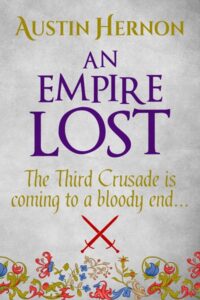
1192
Having defeated Saladin’s forces in Jaffa, Richard the Lionheart has sent his queen, Berengaria of Navarre to Rome while he handles business elsewhere.
Not knowing when the king will return, Berengaria sets about making diplomatic connections with Pope Celestine III and Rome’s high-ranking cardinals.
Disaster strikes when the news arrives that Richard is being held hostage by Holy Roman Emperor Heinrich VI — a major political rival. Horrified, Berengaria and the king’s mother, Eleanor of Aquitaine, begin to raise funds to pay his ransom.
But not everyone is so eager to see Richard’s release. Having designs on England’s throne and the king’s French possessions, Richard’s brother, Prince John, has revolted in his absence, supported by King Philip of France. Together, they conspire to prolong Richard’s captivity.
With tensions rising throughout Europe, Berengaria worries that she will once more be caught in the middle of a war. And without her husband by her side, she begins to despair of ever producing an heir to secure England’s unwieldy throne…
Will Berengaria and Richard ever be reunited? Will they be able to secure England’s line of succession and their lands in France?
Or is Richard’s empire destined to fall…?
Congratulations to Amy Licence, whose intriguing Tudor drama, Lady of Misrule, is published today!
Lady of Misrule is the fourth book in The Marwood Family Tudor Saga.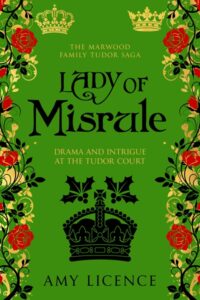
1528
The mood at court is sombre. The fractures in the royal marriage are spreading and King Henry’s desires are threatening the stability of the realm.
Eighteen-year-old Thomasin Marwood feels aged beyond her years in service to Queen Catherine of Aragon.
Her time as a lady-in-waiting has exposed her to intrigues and dark plots that have cast a shadow over her future.
And now King Henry is becoming more open in his plot to divorce the queen and marry Lady Anne Boleyn.
Queen Catherine has sent for her daughter, Princess Mary to join her at court and remind Henry of his fatherly duties. But Anne Boleyn is always at Henry’s side, resplendent in her lavish gowns, reminding the king of her youth and ability to carry an heir.
Thomasin is loyal to her mistress, Queen Catherine, but she finds herself noticed by the Boleyns and she fears her position at court may soon change.
What will happen to Thomasin if the king is successful in his petition for a divorce? Will Queen Catherine be cast out of court?
And will Lady Anne Boleyn finally get the throne she has been lusting after…?
Lynne Reid Banks, author of over forty published books for children and adults, has died at the age of 94.
Born in Barnes, London in 1929 to a Scottish doctor and an Irish actress, Lynne was evacuated to Canada at the start of the Second World War, where she spent five years. She returned to London and attended RADA before working at ITN as one of the UK’s first female television journalists. Her first novel, The L-Shaped Room, was published in 1960 and despite causing outrage at the time for its portrayal of an unmarried mother-to-be, was later adapted for cinema to great critical acclaim.
In the early 1960s Lynne went to live in Israel with her husband, the sculptor Chaim Stephenson, where she taught English. In 1971 she brought her family back to London where she continued to write, including the 1980 bestselling children’s book, The Indian in the Cupboard.
In 2013 Lynne won the prestigious J.M. Barrie Award ‘in recognition of a lifetime’s achievement in delighting children’.
We at Sapere Books were honoured to be chosen to reissue some of Lynne’s backlist over the past five years.
Lynne Reid Banks (31 July 1929 — 4 April 2024)

